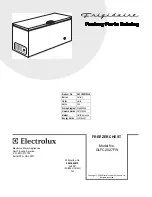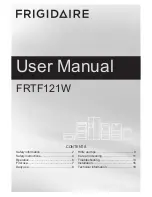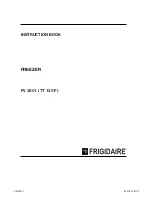
36
DO937DV
EN
· Your appliance uses isobutane (R600a) as a refrigerant. Although R600a is an environmentally friendly
and natural gas, it is explosive. Therefore you should be careful during shipment and installation
to prevent your appliance’s cooler elements from being damaged. In the event of a leak caused by
damage to the cooler elements, move your fridge from open flame or heat sources and ventilate the
room where the appliance is located for a few minutes.
USE
TEMPERATURE CONTROL
The freezer is controlled with a temperature control knob located inside the appliance. Adjust the control
knob as desired to suit your individual preference. There are three different setting, with MIN being the
warmest and MAX the coldest.
· The running time and temperature are affected by where the freezer is located, how
often the door is opened and the temperature of the room the freezer is located in.
· When you use the appliance for the first time or after defrosting, adjust the control
knob to the coldest setting for at least 2 hours before introducing food to be stored,
and then readjust to the middle setting.
FREEZING AND STORING FOOD IN THE FREEZER
Use the freezer
· To store deep-frozen food.
· To make ice cubes.
· To freeze food.
Note: Ensure that the freezer door has been closed properly. Avoid opening the freezer drawers
unnecessarily.
Purchasing frozen food
· Packaging must not be damaged.
· Use by the ‘use by /best before/best by/’ date.
· If possible, transport deep-frozen food in an insulated bag and place quickly in the freezer.
Freezing fresh food
Freeze fresh and undamaged food only. To retain the best possible nutritional value, flavour and colour,
vegetables should be blanched before freezing.
Aubergines, peppers, zucchini and asparagus do not require blanching.
Note: Keep food to be frozen away from food which is already frozen.
· The following foods are suitable for freezing: Cakes and pastries, fish and seafood, meat, game,
poultry, vegetables, fruit, herbs, eggs without shells, dairy products such as cheese and butter, ready
meals and leftovers such as soups, stews, cooked meat and fish, potato dishes, soufflés and desserts.
· The following foods are not suitable for freezing:Types of vegetables, which are usually consumed raw,
such as lettuce or radishes, eggs in shells, grapes, whole apples, pears and peaches, hard-boiled eggs,
yoghurt, soured milk, sour cream, and mayonnaise.
Packing frozen food
To prevent food from losing its flavour or drying out, place food in airtight packaging.
1.
Place food in packaging.
2.
Remove air.
















































